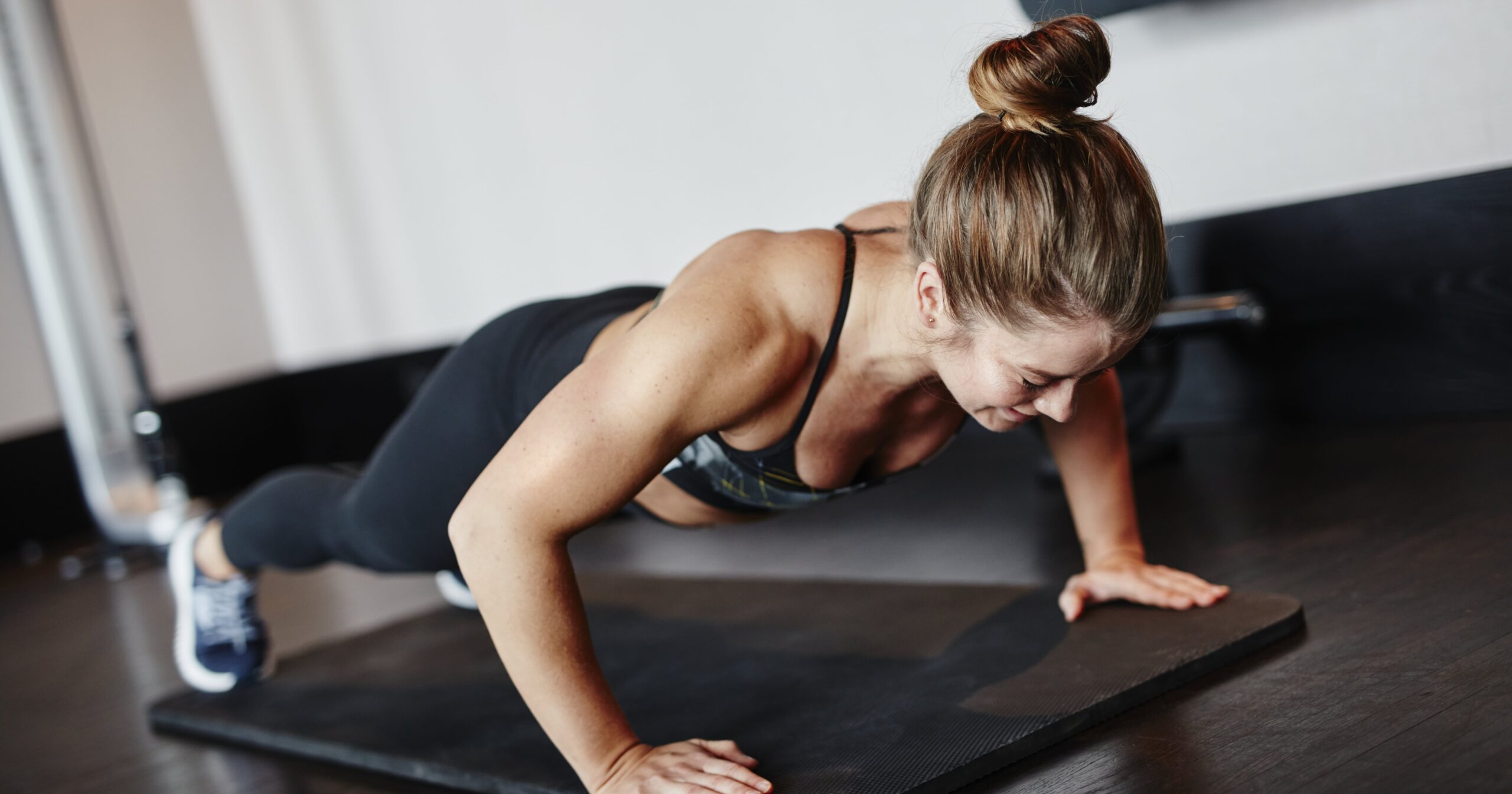If there’s one exercise that always makes me shiver in my gym shoes, it’s burpees. Love them or hate them, burpees are included in many high-intensity workouts. The basic burpee exercise combines a jump, squat, plank, and push-up to create an intense sequence that works just about every muscle group in your body. And while there are lots of ways to modify this move, a round of burpees is still likely to leave your heart pounding. No matter what modifications you choose, learning how to do a burpee correctly is essential in order to prevent injury and maximize the overall benefits.
Burpees may get your heart rate up, but they’re also highly contested, even among pros in the industry. “Overall, I’m antiburpee,” says coach and trainer Rachel Prairie. “There is a time and a place to sprinkle them in, but smart programming will have strength training at its core and only use burpees as a tool to integrate high-intensity cardio or as an occasional challenge. There’s no need to be doing them every week.”
Grace Taylor, PT, DPT, says that burpees can be beneficial — when they’re executed the right way. “When done correctly, the burpee can have incredible health benefits, but it’s very easy to compensate and do more harm than good,” she says. And they’re not for everyone. If you have a heart condition or pain in your hips, lower back, shoulders, or wrists, for example, Taylor doesn’t recommend adding burpees to your workouts. For anyone starting out or unsure of their form, she recommends performing burpees in front of a certified trainer or physical therapist to make sure you’re doing them properly.
To learn how to do a burpee exercise with proper form, Prairie and Taylor walk us through the basics, sharing whether or not the burpee benefits live up to all the hype. Find their best burpee tips below, plus modifications to help make burpees a little more bearable.
The Benefits of Burpees
“Burpees are a very effective full-body exercise,” Taylor says. “They activate many muscles, including the glutes, hip flexors, quads, hamstrings, pecs, lats, and triceps.” Strengthening these muscles can increase your tolerance for lifting, carrying, squatting, and jumping. This may help with everyday activities that utilize these motions. Because burpees expend lots of energy, working both your strength and endurance, Prairie says you can consider them a two-for-one cardio and strength exercise.
Another burpee benefit is the fact that they’re so challenging despite requiring little space and zero equipment, Prairie says. “If you’re looking for a quick burn: burpees!”
How to Do a Burpee
Burpees combine a lot of motions and require a lot of energy, so it’s easy to lose form. “A lot of people skip the squat in preparation for the jump,” Taylor says. This forces other muscles to compensate and makes the exercise less effective. Additionally, skipping the squat makes it harder to maintain a neutral spine, which is crucial for eliminating irritation to the mid and low back, Taylor says. To prevent lower-back pain, make sure you avoid rounding your back when you squat down to put your hands on the floor.
Prairie emphasizes the importance of warming up before you dive into this total-body movement, to help prevent injury. Prairie and Taylor both recommend remembering to breathe throughout the exercise and making sure you don’t arch your back when you’re in the plank position.
- Start standing with your feet about shoulder-width apart.
- Keeping your spine neutral and your core engaged, lower into a squat. Place both palms flat on the floor in front of you, about shoulder-width apart. Your knees should be on either side of your elbows.
- Gazing at the ground slightly in front of you, jump both legs back into a high plank. You should be able to draw a straight line from the back of your head to your toes: don’t allow your hips to droop, and keep your shoulders stacked over your wrists.
- Lower into a push-up, keeping your elbows within six inches of your sides. Make sure to move your body as one piece: think of it as a moving plank.
- Push yourself back up to a high plank, then jump both feet forward to return to a low squat.
- From the squat, jump up, pushing off the floor to extend your legs and reaching your arms overhead.
- Land softly with your knees bent. That’s one rep.
Burpee Variation: Low-Impact Burpee
To make the burpee exercise a low-impact move, you can modify it by walking into and out of the plank so that you avoid jumping. To modify the push-up, you can perform that part of the move with your knees on the floor.
- Start standing with your feet about shoulder-width apart.
- Keeping your spine neutral and your core engaged, lower into a squat. Place both palms flat on the floor in front of you, about shoulder-width apart. Your knees should be on either side of your elbows.
- Gazing at the ground slightly in front of you, step both legs back into a high plank. You should be able to draw a straight line from the back of your head to your toes: don’t allow your hips to droop, and keep your shoulders stacked over your wrists.
- Lower into a push-up, keeping your elbows within six inches of your sides. Make sure to move your body as one piece: think of it as a moving plank.
- Push yourself back up to a high plank, then step both feet forward one at a time to return to a low squat.
- From the squat, stand up, extending your legs and reaching your arms overhead. If you’d like, you can also lift onto your tiptoes.
- That’s one rep.
Burpee Variation: Elevated Burpee
Prairie recommends making burpees easier by using a box or bench to elevate your hands instead of going all the way down to the floor.
- Start standing with your feet about shoulder-width apart just in front of a bench.
- Keeping your spine neutral and your core engaged, lower into a squat. Place both palms flat on the bench in front of you, about shoulder-width apart.
- Jump or step both legs back into a high plank. You should be able to draw a straight line from the back of your head to your toes: don’t allow your hips to droop.
- Lower into a push-up, keeping your elbows within six inches of your sides. Make sure to move your body as one piece: think of it as a moving plank.
- Push yourself back up to a high plank, then step or jump both feet forward to return to a squat.
- From the squat, immediately jump up, extending your legs and reaching your arms overhead.
- Land softly with your knees bent. That’s one rep.
Burpee Variation: Squat Thrust
You can also eliminate the push-up and just stay in a high plank when jumping back and forward, says Taylor. If you also nix the jump at the top of the burpee, then that’s usually called a squat thrust. The jump at the end is optional.
- Start standing with your feet about shoulder-width apart.
- Keeping your spine neutral and your core engaged, lower into a squat. Place both palms flat on the floor in front of you, about shoulder-width apart. Your knees should be on either side of your elbows.
- Gazing at the ground slightly in front of you, jump both legs back into a high plank. You should be able to draw a straight line from the back of your head to your toes: don’t allow your hips to droop, and keep your shoulders stacked over your wrists.
- Jump both feet forward to return to a low squat.
- From the squat, jump up, pushing off the floor to extend your legs and reaching your arms overhead.
- Land softly with your knees bent. That’s one rep.
Burpee Variation: Chest-to-Floor Burpee
You may think of this as a CrossFit-style burpee or a chest-to-floor burpee. In either case, it’s a burpee where you don’t stop in a high plank position and perform a push-up; rather, you jump back into a plank and immediately lower your whole body onto the floor.
- Start standing with your feet about shoulder-width apart.
- Keeping your spine neutral and your core engaged, lower into a squat. Place both palms flat on the floor in front of you, about shoulder-width apart. Your knees should be on either side of your elbows.
- Gazing at the ground slightly in front of you, jump both legs back into a high plank.
- Immediately lower your body to the ground.
- Push your chest and hips up off the floor and then jump both feet forward to return to a low squat.
- From the squat, jump up, pushing off the floor to extend your legs and reaching your arms overhead.
- Land softly with your knees bent. That’s one rep.


